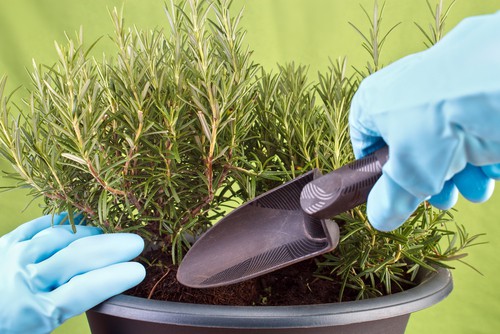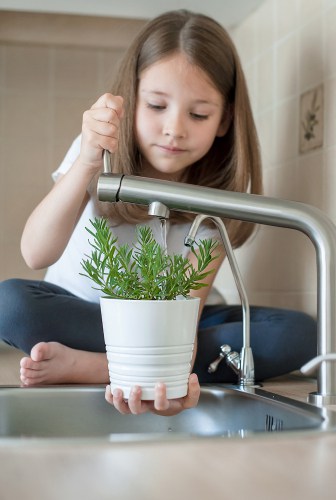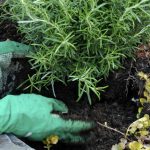Last updated on March 7th, 2022
Our site is reader supported, this means we may earn a small commission from Amazon and other affiliates when you buy through links on our site.
Rosemary makes for a savoury addition to many dishes. It offers a pungent flavour in each of its needle-like leaves and truly is such an effectively grown herb that you can grow rosemary in containers and regularly clip away short pieces of the stem, and as long as you don’t get down to the old wood the Rosemary will continue to grow effectively. With just a little bit of effort, you can have fresh Rosemary to add flavour to a variety of dishes or simply grow this beautiful herb as an ornamental plant with blue flowers.
How to grow Rosemary in pots
Choosing a pot and compost
When you plant rosemary, you need to be considerate of the fact that it is a prolific grower, so if you want it to get quite large and take on the shape of a big bush you should start off with a bigger container. Growing Rosemary in containers requires a soil-based or multipurpose compost mixture which you can combine with perlite or grit in order to allow create better drainage. Two parts compost to one part grit is usually about right and helps improve drainage. You want to make sure that whatever pot you choose is it least 30cm across so that the roots have enough space to grow and to expand effectively.

Ensure you have drainage holes and stones in the bottom of the pot
Before you plant the Rosemary make sure that your container has enough drainage. Your Rosemary won’t grow effectively if it’s in poorly drained soil and sometimes the pots you buy in garden centres and nurseries only have three or four holes in the middle and some plastic containers have no holes at all, so will need drilling first to create some.
Rosemary plants hate having wet roots so it is essential you provide the pots they are planted in enough drainage, so if there aren’t any (or enough) if the pot you have purchased you will need to add some before planting them. Always add a little stop to the bottom of the pot as well to ensure the soil does not block the holes, if you have any broken pots, this is usually ideal for use as crockery in the bottom of pots.
Growing them from a young plant is best – avoid sowing seeds
The simplest way to grow rosemary is to purchase a small plant that’s already started from a nursery or garden centre and most will have it amongst the herbs. Rosemary can be quite difficult to grow from seed so we don’t recommend this and it will save you a great deal of time and hassle if you simply buy a pre-started plant. Taking cuttings is a better option but this will take some time before the cuttings are established enough to be grown in a large pot, plus you need a plant to take cutting from.
When you plant the Rosemary in the container make sure that it is at the same depth as it was planted in the pot in which it was purchased. If you place it too deeply into the soil it can actually kill the plant.
Position and winter protection
Rosemary prefers full sun, so with this in mind, give it a great deal of sun wherever you placed the containers, and if you live in an area with very cold winters, bring it indoors before the first frosts so that it can survive the winter. To care for it over winter you need to find a sunny location where the plant won’t get too cold but is still going to enjoy air circulation and sunlight, if you have a cold greenhouse this is usually enough to get them through the winter.
Alternatively, if you don’t want to bring it inside and continue growing it indoors during the winter you can always grow it as an annual herb and just start over each spring. You can also try covering the plant with fleece and wrap some lagging around the pot to protect the roots.
Regular Care
Watering and feeding
Caring for a Rosemary is very simple. You just need to make sure that you water it properly. Check the first 6cm or so of the soil and if it feels dry then it’s time to water. You don’t want to let your container stand in water because this can lead to root rot. Rosemary is very strong and doesn’t typically require any fertiliser, however, you can add some dry fertiliser if your plant is starting to look a little yellow.

Harvesting
When you are cooking and you are ready to add Rosemary from your container to your kitchen, look at each of the stems. You will be able to see the older wood that is brown in colour and at the tips, you will see the greener new growth. You can clip away the green growth and add the needle-like leaves to your meals and the plant will heal itself and continue growing very effectively. If you clip away down to the older wood it won’t grow anymore so only ever remove the newer green growth.
When you prune, you are aiming to keep the shape as desired.
Image credit – Shutterstock.com


